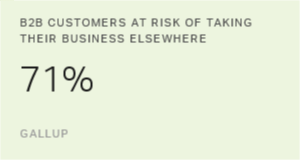Story Highlights
- Most banking leaders assume better service will increase costs
- Gallup analysis of Latin American call center proves otherwise
- Top customer scores associated with lower call times
The trend of customers seeking a primary bank continues to increase in Latin America. This means banks should prepare for a surge in costs to meet these new customers' needs.
For most financial institutions, a significant portion of their cost structure comes from serving customers through a call center. To keep costs as low as possible, most call center managers continually remind their employees to handle calls quickly. Offering friendly service gets in the way of this objective, it seems.

But Gallup's recent experience with a major bank in Mexico shows that good customer service doesn't necessarily increase costs. After working with the bank's call center for nearly two years, Gallup investigated the relationship between average handling time for each inquiry and scores on several key customer service metrics. Based on data for the first quarter of 2015, Gallup compared workgroups with the highest customer service metric scores (those in the top 30%) with the rest of the workgroups. The results show:
- For top-performing workgroups based on customer service metric scores, average handling time per call is 2.4% lower than it is for the rest of the workgroups.
- More importantly, first-call resolution is 6.1% higher for top-performing workgroups than for their lower-performing counterparts.
At first glance, the findings suggest a positive relationship between good customer service and better operational outcomes (average handling time and first-call resolution). Yet the results could also suggest that the higher first-call resolution rates are responsible for driving the results, rather than a better customer service experience overall. In other words, workgroups with higher first-call resolution rates may be more effective at solving problems at a faster pace and thus receive higher customer satisfaction scores.
To validate the initial findings, Gallup selected only those workgroups with the highest first-call resolution scores (those in the top 30% on this metric) and compared the average handling times between groups with high customer service metric scores (using the same criteria as for the previous analysis) and groups below the threshold, or with lower customer service metric scores. The results are telling:
- Within the validation group, 52% of the workgroups have customer service metric scores above the original threshold.
- Average handling time for these workgroups is 5.3% lower than the remaining 48% of workgroups in the validation group.
The results become even more significant when comparing workgroups with top scores for first-call resolution and customer service metrics with the average of all remaining workgroups. Not only does the duration of calls drop by 6.1% among this elite group, but first-call resolution also increases by nearly 13%.
Improving Customer Engagement Doesn't Have to Hurt the Bottom Line
There are important lessons to learn from this case study. Gallup's analysis provides some powerful insights for the future of call center customer service in Latin America and beyond, both within the financial services industry and in other industries.
Requiring employees to focus exclusively on short-term operational metrics could have long-term consequences for companies. Though encouraging customers to use digital technologies rather than call centers could bring significant cost savings, leaders shouldn't forget that customers in many areas of the world still prefer to solve problems with other human beings rather than with machines.
Until customer preferences change, focusing on increasing customer engagement with call centers may yield the biggest gains. Asking call center employees to focus on increasing customer satisfaction may not only encourage them to provide exceptional customer service but also motivate them to solve customers' problems during the first call, thus reducing the overall number of calls. Contrary to conventional wisdom, improving customer satisfaction won't necessarily have a negative effect on an organization's bottom line.
